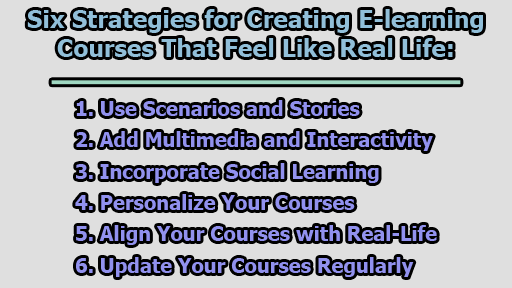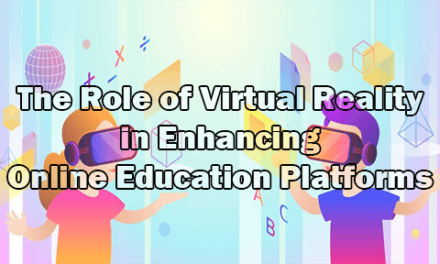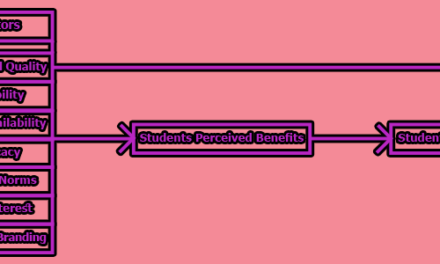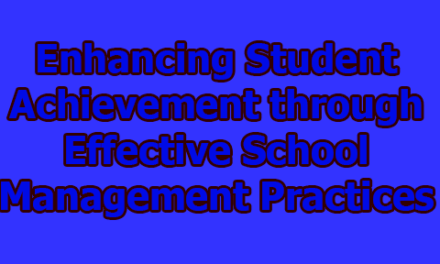Six Strategies for Creating E-learning Courses That Feel Like Real Life:
E-learning has revolutionized the way we acquire knowledge and develop new skills. However, it’s not uncommon for online courses to feel dull, impersonal, and disconnected from real-life experiences. To address this issue, educators and course designers must take proactive steps to make e-learning courses more engaging, interactive, and realistic for learners. In this article, we’ll explore six strategies for creating e-learning courses that feel like real life.
1. Use Scenarios and Stories: One of the most effective ways to make e-learning courses feel like real life is by incorporating scenarios and stories that relate to the learners’ goals, challenges, and experiences. Scenarios and stories have the power to bridge the gap between theory and practice, allowing learners to apply what they’ve learned to authentic situations.
To create effective scenarios and stories, course designers must:
- Understand the Audience: Knowing your audience’s backgrounds, motivations, and learning styles is crucial to crafting relevant scenarios.
- Define Learning Objectives: Clearly outline what you want learners to achieve, ensuring that scenarios align with these objectives.
- Craft Realistic Situations: Create scenarios that challenge learners to think critically and make decisions that mirror real-life situations.
Scenarios and stories add an element of fun, memorability, and practicality to e-learning, helping learners connect theoretical knowledge to practical application.
2. Add Multimedia and Interactivity: Multimedia and interactivity are indispensable tools for making e-learning courses feel like real life. They cater to the diverse preferences and senses of learners, keeping them engaged and immersed in the course content.
To make the best use of multimedia and interactivity:
- Choose Wisely: Select multimedia elements like images, videos, audio, animations, and simulations that enhance the learning experience without overwhelming learners.
- Encourage Engagement: Incorporate interactive elements such as quizzes, games, and polls to keep learners actively involved.
- Provide Feedback: Offer constructive feedback on assessments and activities to reinforce learning.
The judicious use of multimedia and interactivity can simplify complex concepts, making them more accessible to learners, and create an immersive, real-life learning environment.
3. Incorporate Social Learning: Social learning promotes collaboration, communication, and a sense of community among learners, making e-learning feel more like a shared real-life experience. Learners can benefit from peer interactions, exchange ideas and opinions, and feel less isolated or bored.
To incorporate social learning effectively:
- Establish Guidelines: Define clear guidelines and roles for learners in online forums, chats, webinars, or discussion boards.
- Facilitate Interaction: Encourage and monitor learner interactions to maintain a positive learning environment.
- Encourage Peer Reviews: Peer reviews can help learners assess and provide feedback to their fellow students, enhancing the learning process.
By fostering collaboration and community within your e-learning courses, you create a dynamic and engaging environment that mirrors real-life social interactions.
4. Personalize Your Courses: Personalization is a key element in making e-learning courses feel relevant and valuable to learners. Tailoring courses to individual needs, interests, and preferences can significantly increase learner engagement and satisfaction.
To personalize your courses effectively:
- Collect Data: Gather information about your learners to understand their preferences and requirements.
- Offer Flexibility: Provide options and choices in the course structure, allowing learners to select content or activities that match their learning style.
- Respect Autonomy: Ensure learners have control over their learning path, giving them a sense of ownership.
Personalized e-learning courses demonstrate a commitment to addressing learners’ unique needs and preferences, making the content more relatable and engaging.
5. Align Your Courses with Real-Life: To make e-learning courses feel like real life, they must align with the expectations, standards, and outcomes of the learners’ real-world experiences. This alignment helps learners see the practical value of the course content.
To align your courses with real life:
- Define Purpose: Clearly articulate the objectives and expected outcomes of your course.
- Match Content: Ensure that the content, activities, and assessments align with the course’s intended purpose.
- Emphasize Application: Include activities that encourage learners to apply their knowledge to real-life scenarios.
Alignment with real-life expectations and outcomes enhances the effectiveness and relevance of e-learning courses.
6. Update Your Courses Regularly: In the fast-paced world of education and industry, it’s essential to update e-learning courses regularly to reflect the latest trends, developments, and feedback. Outdated content can leave learners feeling disconnected from real-world practices and knowledge.
To keep your courses up-to-date:
- Monitor and Evaluate: Continuously assess the effectiveness of your courses, identify gaps, and gather learner feedback.
- Identify Opportunities: Stay informed about the latest developments in your field and identify opportunities to enhance your courses.
- Implement Changes: Act on the feedback and update your courses with new content, revised material, and the removal of outdated information.
Regular updates ensure that your e-learning courses remain current and relevant, keeping learners informed and competitive in their field.
In conclusion, making e-learning courses feel like real life is a crucial objective for educators and course designers. By incorporating scenarios, multimedia, interactivity, social learning, personalization, alignment with real life, and regular updates, educators can create engaging, interactive, and relevant e-learning experiences that bridge the gap between theoretical knowledge and practical application. In doing so, learners can acquire new skills and knowledge that are not only useful but also enjoyable to attain.

Former Student at Rajshahi University










